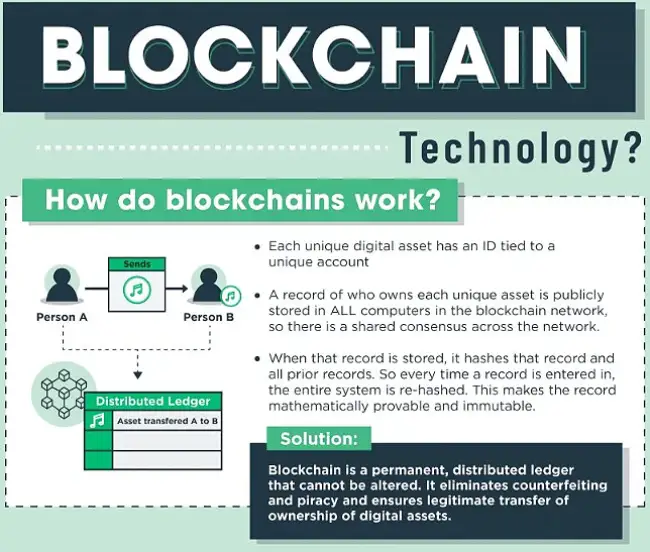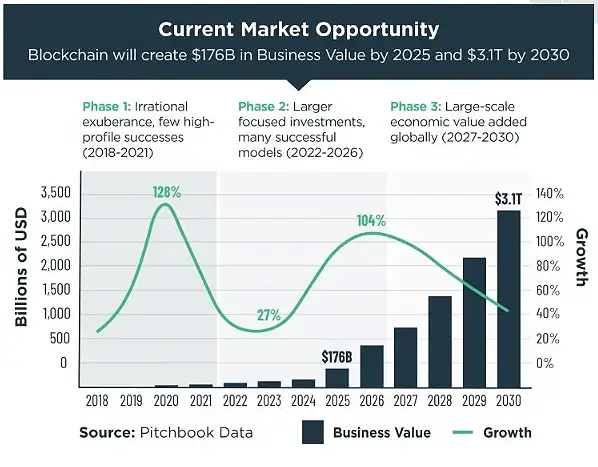In the fast-paced digital landscape of today, blockchain has emerged as an attention-grabbing and exciting technology. Often associated with cryptocurrencies like Bitcoin, blockchain has evolved beyond its origins to become a groundbreaking technology with far-reaching implications. In this article learn the complexities of blockchain in simple words and also explore its core principles, diverse applications, benefits, drawbacks, and how it will play a great role in shaping the coming future.
Contents
The Core of Blockchain Technology
At its core, blockchain is a decentralized and distributed digital ledger that records transactions securely and transparently. This ledger is composed of a chain of blocks, each containing a batch of transactions and a unique cryptographic hash. This fundamental structure ensures that data is immutable, and the distributed nature of the network eliminates the need for a central authority.
Key Characteristics and Components of Blockchain
- Decentralization: Unlike traditional systems where a central authority oversees transactions, blockchain operates through a network of nodes. This decentralized architecture enhances security and trust by eliminating single points of control.
- Cryptography: Transactions within a blockchain are secured using complex cryptographic algorithms. This guarantees the integrity and confidentiality of data, providing a level of security crucial for digital transactions.
- Consensus Mechanisms: To validate transactions, blockchain networks employ consensus mechanisms like Proof of Work (PoW) and Proof of Stake (PoS). These mechanisms ensure agreement among network participants, enhancing the reliability of the ledger.
Applications of Blockchain
- Cryptocurrencies: The birth of blockchain is closely intertwined with the rise of cryptocurrencies. Bitcoin, the first cryptocurrency, introduced the concept of peer-to-peer digital transactions, setting the stage for a financial revolution, and within years a large number of other cryptocurrencies were introduced like Ethereum, Litecoin, etc.
- Supply Chain Management: Blockchain’s transparency and traceability make it invaluable for supply chains. Industries can now monitor the journey of products from origin to consumers, minimizing fraud and improving efficiency.
- Smart Contracts: These self-executing contracts automatically enforce predefined rules when specific conditions are met. From real estate to healthcare, smart contracts streamline processes and reduce intermediaries.
- Healthcare and Data Security: Blockchain enhances data sharing and security in healthcare. Patient records can be securely shared among medical professionals while ensuring privacy and compliance.
- Finance and Beyond: Beyond cryptocurrencies, blockchain is reshaping finance through quicker cross-border transactions and efficient identity verification processes. The technology’s potential extends to voting systems, intellectual property management, and more.
Seizing the Advantages and Tackling Challenges
Advantages of Blockchain
- Transparency: Blockchain’s transparency instills trust as all participants share the same information.
- Security: Cryptography and decentralization make blockchain highly secure against tampering and fraud.
- Efficiency: Automation through smart contracts reduces manual intervention and minimizes errors.
- Cost Reduction: Removing intermediaries decreases costs in transactions and processes.
Challenges and Drawbacks
- Scalability: Current blockchain networks face scalability issues due to their distributed nature.
- Energy Consumption: Some consensus mechanisms demand significant energy, sparking concerns about sustainability.
- Regulatory Uncertainty: Evolving regulations impact the widespread adoption of blockchain technology.
- Privacy Concerns: Striking a balance between transparency and data privacy remains a challenge.
Frauds and Vulnerabilities
Despite its security mechanisms, blockchain is not immune to fraud and vulnerabilities. The anonymous nature of some transactions has led to instances of money laundering and illegal activities. Moreover, the human element can still introduce errors or malicious activities that exploit vulnerabilities in the technology, which is why more Research and Development are needed to improve this Technology.
Blockchain’s Potential in the Future
Blockchain’s journey has just begun, and its future potential is boundless. As scalability and energy efficiency improve, blockchain is set to reshape industries and transactions. Interoperable blockchains and the fusion of blockchain with emerging technologies like AI could lead to unprecedented innovations. This trajectory of blockchain’s development will thrust it into the spotlight as a technology set to redefine industries and reshape the future in ways that were once considered unimaginable. As the technology continues to evolve and overcome its current limitations, its potential becomes even more apparent. The interplay of innovation, connectivity, and adaptability will push blockchain into a realm where its transformative power is both promising and profound. In the below infographic, you can see the future business value of Blockchain technology.
The rapid evolution of blockchain technology and the huge amount of investment into this technology have generated excitement and anticipation for its potential to revolutionize industries and redefine the future. However, alongside its promise, the potential for misuse and unintended consequences cannot be ignored. Striking a delicate balance between harnessing innovation and mitigating misuse is essential to ensure that blockchain’s transformative power leads to positive outcomes without facilitating harmful activities.
Scalability and Interoperability
One of the primary challenges blockchain faces is scalability – the ability to handle a growing number of transactions without compromising speed and efficiency and charges such as Gas fees. In the future, advancements in consensus mechanisms and network architectures could lead to improved scalability and lower transactional fees. Moreover, the rise of interoperable blockchains, where different chains can seamlessly communicate and share data, could revolutionize industries that demand complex data interactions, such as supply chains healthcare, and more.
While scalability solutions hold the promise of faster and more efficient transactions with lower gas fees, the rush to achieve scalability must not compromise security. Rapid expansion can introduce vulnerabilities that malicious actors might exploit. Interoperability, while facilitating data sharing, could also become an avenue for spreading misinformation or unauthorized access. Ensuring rigorous security protocols while enhancing scalability and interoperability is crucial.
Integration with Artificial Intelligence (AI)
The fusion of blockchain technology with AI has the potential to create dynamic and intelligent systems. Blockchain’s secure and transparent nature can provide the foundation for trustworthy data sharing among AI models and systems. This synergy could drive the development of AI-driven smart contracts, automated decision-making, and predictive analytics, enhancing efficiency and accuracy across a wide range of applications.
The integration of AI and blockchain can unlock lots of possibilities, but it also demands ethical considerations that should be addressed and solved effectively. The fusion of these technologies could lead to automated decision-making processes that raise questions about accountability and transparency. Preventing AI algorithms from perpetuating biases or unintended actions is a challenge that necessitates careful oversight.
Decentralized Finance (DeFi) and Beyond
Decentralized finance (DeFi) has emerged as a key area of interest within the blockchain space. In the future, blockchain could provide the infrastructure for an entire financial ecosystem that operates without intermediaries, enabling lending, borrowing, trading, and investing on a global scale. Additionally, blockchain’s potential extends to digital identities, where individuals have control over their data, reducing the risks associated with data breaches and identity theft.
While DeFi offers financial inclusivity, its decentralized nature can be exploited for illicit financial activities. Regulatory frameworks need to adapt to the evolving landscape to prevent money laundering, fraud, and other financial crimes. Striking a balance between innovation and regulation is essential to ensure DeFi’s benefits are not overshadowed by its potential risks.
Supply Chain Revolution
As blockchain technology matures, supply chains could undergo a profound transformation. The ability to track products at every stage of their journey, verify authenticity, and ensure ethical sourcing could become standard practice. This level of transparency and accountability has the potential to reshape industries ranging from agriculture to luxury goods.
As supply chains become more transparent through blockchain, the potential for spreading false information or manipulating records arises. While blockchain enhances traceability, bad actors could attempt to undermine trust by altering data. Ensuring the accuracy and integrity of the data entered into blockchain-based supply chain systems is paramount.
Government and Administrative Processes
Governments are exploring blockchain’s potential to streamline administrative processes and enhance transparency. Blockchain-based identity systems could simplify citizen interactions while voting systems built on blockchain could eliminate voter fraud and enhance trust in electoral processes. The use of blockchain for secure storage and sharing of official records could lead to more efficient public services.
The use of blockchain for government services and voting systems can enhance transparency and trust. However, safeguarding citizens’ privacy while maintaining the benefits of transparency is a delicate balance. Striking this balance ensures that personal information remains secure and protected.
Central Bank Digital Currencies (CBDCs)
Several central banks are exploring the concept of CBDCs, digital versions of their national currencies built on blockchain technology. CBDCs have the potential to enhance cross-border transactions, reduce costs, and increase financial inclusion. The adoption of CBDCs can streamline financial processes and enhance cross-border transactions. However, these digital currencies could become targets for cyberattacks, potentially disrupting economies and causing financial instability. Implementing robust security measures to protect CBDCs from cyber threats is essential.
Environmental and Social Impact
The growing awareness of environmental sustainability could drive blockchain innovation towards more energy-efficient consensus mechanisms. Additionally, blockchain could play a pivotal role in social impact initiatives, such as ensuring fair wages in global supply chains and enabling secure donations in philanthropy.
As blockchain technology strives for greater energy efficiency, the commitment to responsible innovation becomes crucial. Blockchain’s environmental impact, even with improvements, requires continued monitoring. Additionally, ensuring that blockchain’s potential for positive social impact outweighs its potential for enabling negative behaviors remains a priority.
Conclusion
The potential of blockchain technology in the future is vast and multifaceted. As the technology addresses its current limitations and embraces innovative solutions, its impact on industries, economies, and societies could be transformative. The convergence of blockchain with other emerging technologies and its ability to foster trust, transparency, and security position it as a pivotal force in shaping the world’s digital landscape. The journey ahead is one of continuous exploration and adaptation, where blockchain’s potential unfolds and revolutionizes the way we interact, transact, and envision the future.
Blockchain technology’s emergence has marked a paradigm shift in how we envision trust, transparency, and security in the digital realm. As industries and governments recognize its potential, blockchain is primed to become an integral part of our technological landscape. By fostering innovation, enhancing security, and revolutionizing transactions, blockchain stands as a beacon guiding us into a future where decentralized and transparent systems redefine the way we interact and conduct business, despite the challenges and vulnerabilities that must also be addressed.
Also Read: Metaverse: 3D Virtual Environment of The Internet.
Sources
- Yaga, Dylan, et al. “Blockchain technology overview.” arXiv preprint arXiv:1906.11078 (2019).
- What is Blockchain Technology? – IBM Blockchain | IBM. (n.d.).
- Informat, C. F. E. A. (2022). The core technologies and classifications of blockchain. In Springer eBooks (pp. 5–12).
- Ammous, Saifedean. “Blockchain technology: What is it good for?.” Available at SSRN 2832751 (2016).
- Ahmad, Syed S., Shahzad Khan, and Mohammad A. Kamal. “What is blockchain technology and its significance in the current healthcare system? A brief insight.” Current pharmaceutical design 25.12 (2019): 1402-1408.
- Zheng, Zibin, et al. “An overview of blockchain technology: Architecture, consensus, and future trends.” 2017 IEEE international congress on big data (BigData congress). Ieee, 2017.
- Levis, Daniel, Francesco Fontana, and Elisa Ughetto. “A look into the future of blockchain technology.” Plos one 16.11 (2021): e0258995.
- Srivastava, Gautam, Reza M. Parizi, and Ali Dehghantanha. “The future of blockchain technology in healthcare internet of things security.” Blockchain cybersecurity, trust and privacy (2020): 161-184.
- Zheng, Xian Rong, and Yang Lu. “Blockchain technology–recent research and future trend.” Enterprise Information Systems 16.12 (2022): 1939895.
FACT CHECK: We strive for accuracy and fairness. But if you see something that doesn’t look right, please Contact us.
DISCLOSURE: This Article may contain affiliate links and Sponsored ads, to know more please read our Privacy Policy.
Stay Updated: Follow our WhatsApp Channel and Telegram Channel.
















